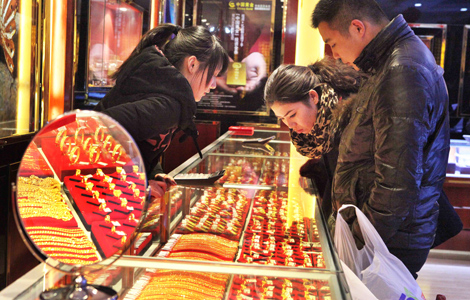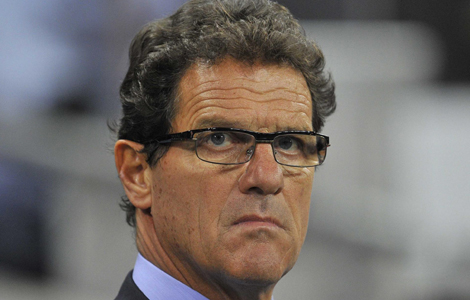China goes for the gold
Updated: 2012-02-17 09:03
By Oswald Chen (China Daily)
|
|||||||||||
|
|
Country likely to surpass India in demand for precious metal in 2012
HONG KONG - China, the largest producer of gold, may also become the biggest consumer of the metal in 2012, overtaking India in that regard, the World Gold Council said on Thursday.
That rise to the top position would come at the same time as an increase in the demand for gold for use in jewelry and as an investment, the council said.
In 2011, China's demand for gold bullion increased by 20 percent to reach 769.8 metric tons, while India's gold consumption declined by 7 percent to hit 933.4 tons. Those changes came about in part because of fluctuations in gold prices and a weak rupee, according to the World Gold Council, a market-development organization for the gold industry. In the second half of the year, the demand for gold increased faster in China than any other place in the world, it added.
"There is a major boost to the overall figures from the increase in Chinese demand, which is a trend that we see continuing over the next year," Marcus Grubb, managing director of investment at the council, said in a statement.
"It is likely that China will emerge as the largest gold market in the world for the first time in 2012."
If the most recent quarter is looked at, rather than an entire year, China has already become the biggest buyer of gold in the world. In the three months leading up to Dec 31, 2011, the country bought 190.9 tons of the metal, and India, during the same time, bought 173 tons, the council said.
"There's a lot of pent-up demand," said Jeremy Friesen, Hong Kong-based commodity strategist at Societe Generale SA. "India and China have grown both in population and in wealth."
Chinese investors bought 258.9 tons of gold bars and coins in 2011, 38 percent more than a year earlier, the council said. The demand for gold jewelry increased by 13 percent to reach 510.9 tons this past year, it added.
"Gold demand in China in 2012 will be well supported by the rise of the middle class in the country," Albert Cheng, Far East managing director for the World Gold Council, told a news conference in Hong Kong on Thursday. "The middle class has a strong demand to consume gold jewelry products. On the investment side, the Chinese middle class would also invest more in gold for asset protection amid rising inflation in Asia and volatile global macroeconomic uncertainty."
The global demand for gold hit a 14-year high in 2011, driven by record low interest rates, rising inflation and central bank purchases, the World Gold Council report said.
Last year, the global demand for gold increased by 0.4 percent to reach 4,067.1 tons, which were worth an estimated $205.5 billion. That was the largest tonnage seen since 1997 and was the result, in large part, of a nearly 5 percent increase in purchases of gold for investment purposes, the report said.
That increase in investment demand was largely attributed to gold purchases made by central banks. Such institutions bought 439.7 tons of gold in 2011, more than at any time since the end of the gold standard in 1971. In 2010, they had bought 77 tons.
"We see the central banks of developing countries in Latin America, Asia and the Far East continuing to bolster their gold holdings to diversify their reserves and protect their reserves against reliance on one or two currencies," Cheng added.
In China, the amount of gold bullion bought for investment purposes stood at 2 tons in 2000. By 2011, that had increased to 259 tons.
Gold prices hit a record of $1,920 an ounce in 2011 and swung between that peak and troughs just above $1,300 an ounce, making 2011 a year of almost unprecedented fluctuation.
From the start of January to mid-February, the price of gold increased by 10 percent to hit about $1,730 an ounce.
Reuters and Bloomberg contributed to this story.










